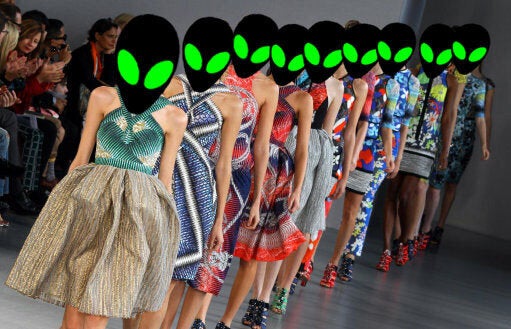Fashion is and should be for all. But for many of the people I know and work with, fashion - and specifically this month's embodiment of creative ingenuity and flamboyance, London Fashion Week - is about as relatable and relevant to their everyday lives as nipping to Mars for a quick charcoal facial.
Why is that? Fashion is a multi billion-dollar industry that filters down from catwalk to high street informing almost every clothing purchase any of us have ever made. Fact. London and the UK are forerunners in style innovation, our talents spotlight us around the world, and we have produced some of the most exciting design talent adored by the global glitterati in years; JW Anderson, Christopher Kane and Holly Fulton to name but a few. Fact.
Yet the conundrum is, and the real Fact remains, that to the average - fashion conscious, I might add - Jo/Joe on the street, the industry feels like a totally remote and intimidating Other World. I regularly ask my non-fashion-but-interested-in-fashion friends and clients (who are being styled and therefore have an interest in looking lovely) why that is? Their resounding reply is a cacophony of 'Who'd wear that on the tube? Thin people! Fashion androids! A world a million miles from my own.'

Whilst we all secretly enjoy lusting after the aspirational lives of the rich and famous, watching Suki, Cara and Kendall fall out of clubs and flirting with the fantasy that we'd be their perfect fourth wheel, it is critical that we strip back all the circus and understand exactly how fashion is and should be for all.
First and foremost, fashion is about confidence. You look good, you feel better. And anyone can own that, not just a size zeroid strutting down a catwalk. In fact, some of the most insecure people I've ever met are models. And some of the most lovely, accommodating and mindful are designers. Everyday I see the most insanely stylish people owning it around Budgens, the post office, the park. Some with a pram, others with a walking stick. Not because they're dripping in couture but because they're oozing confidence.
Fashion should be a statement, a coat of armour that shouts, loud and proud, I'm here and this is me. You just need to put yourself first every now and again, spend a bit of time making the effort to look your best and feel confident in your body, whatever shape or size you are.
Take my 75 year old mother-in-law, for example, who was visiting recently and would snort with laughter if she heard me describe her as a fashionista. She appeared one morning in a bobby dazzler of a twin set from M&S, a dash of lippy and to me became the embodiment of style and confidence. We are lucking enough to live in a country with the most incredible high street, a high street that is a direct representative of the beautiful collections that we will see wafting down the catwalks of London over the next week.
Furthermore, fashion should be viewed as a kind of visual therapy. A tool with which to help us feel better. For many of us, however, watching models prance around the Fashion Weeks of the world does the opposite, compounding our own shortcomings and feelings of insecurity. But that isn't the correct understanding of Fashion. LFW may be the showcasing of an essence of an industry but that world filters down and works in so many other, wonderful and empowering ways.
Over the past few years I have worked with some truly exceptional people who understand and embrace the true and inclusive meaning of fashion as therapy. These include a young woman adjusting to life with a colostomy bag, women suffering from post-natal depression, post-operative women recovering from chemo and mastectomy surgery, and another with such acute psoriasis she would never consider showing her limbs, even through tights. For these people looking good wasn't an option for so long; too paralysed were they by body dysmorphia. And yet all experienced a turning point when the power of a good outfit gave them a critical boost to their confidence, self-esteem and sense of wellbeing. What could be more inclusive and enabling of fashion than that?
So on the eve of LFW with all its Other Worldliness, let us hold onto the fundamental feel good power that radiates down from those catwalks, across all of our lives and remember that Fashion is for One and All.